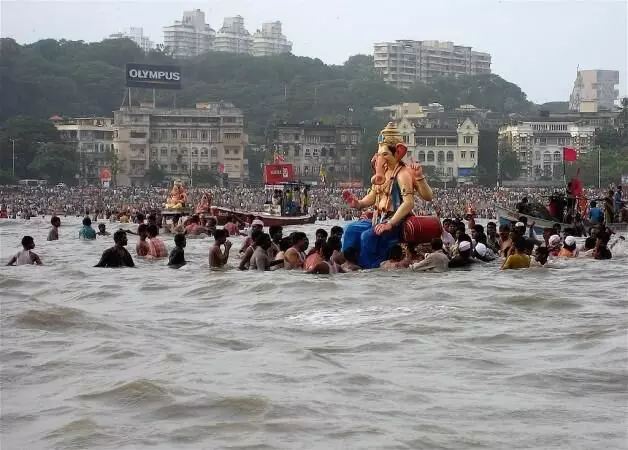Sacred Circularity
The Punarvartan initiative in Maharashtra has transformed the ritual of idol immersion into a zero-waste, community-led practice that preserves tradition, nature, and resources

Punaravartan is a Sanskrit term which means rebirth or renewal—a refreshment of form. In texts like the Bhagavad Gita, it is used as a reminder to Arjuna that Nature works in cycles and that the closing of the loop is essential in all of life's processes.
This circularity is inherent in Indian philosophy, and the Hindu rituals of immersion—known as Visarjan—are a reminder that what has come from the Earth must return to its source. However, in modern times, the immersion rituals, when done with toxic chemical and industrial materials, have become a cause of significant pollution.
The Punaravartan campaign aims to return circularity to Indian festivals, to ensure that none of the materials used in celebrations create waste, and that natural resources are conserved and reused with respect.
Specifically, in the festival of Ganesh Chaturthi, it addresses the problem caused by the immersion of lakhs of idols into natural water bodies, creating pollution. It encourages the use of natural soils (shaadu maati) and the practice of immersing such idols at home. The resulting clay sludge can then be collected and returned to the artisans, who can reuse it endlessly.
This achieves two things: firstly, it prevents the immersion of idols into natural water bodies; and secondly, it conserves the clay—a non-renewable resource that is rapidly depleting—and loops it back into the supply chain.
The Punaravartan campaign was initiated by the eCoexist Foundation, a Pune-based environmental organisation, in 2020 with a small experiment involving just 30 idols to test its feasibility. By 2023, the campaign was adopted by a large network of organisations in Pune city, who joined hands to collect 23,000 kg of clay from individual homes. In 2024, the Pune Municipal Corporation also stepped forward to implement the campaign, and nearly 5 tons were collected from public immersion tanks as well. By the end of 2024, a total of 57,000 kg of clay was collected from the three cities of Pune, Pimpri-Chinchwad, and Thane.
The activity upholds respect for both sentiment and tradition as well as for Nature. It has been very well received by the public and was also presented to the Maharashtra Chief Minister, Eknath Shinde, who recommended that it be replicated across the state. The Maharashtra Pollution Control Board sent out a letter to the 43 AMRUT cities across Maharashtra instructing them to replicate the campaign in their regions. To enable this, eCoexist Foundation will be signing an MoU with the Majhi Vasundhara Abhiyaan to offer training and capacity building to urban and rural local bodies across the state.
Beyond the reuse of the clay for idol-making, the collected material has also been given to ceramic designers and architects for application in ceramics and architecture, respectively. Experiments are being carried out to identify the best large-scale uses of this material. The clay (Shaadu Maati) is mined in Gujarat and is used primarily in Western Maharashtra. It is a fine, water-absorbent material capable of intricate detailing. Architects are now exploring its use in wall plasters, construction blocks, rammed earth walls, and as pond lining for percolation ponds. Ceramic designers from the National Institute of Design are investigating its potential for hand-moulded and slip-cast ceramic items and are testing how it responds to heat and glazing.
For a circular economy project such as this to work, many stakeholders have to come together to do their bit. Pune city demonstrated the viability of scaling up the collection because artisans, citizens, waste collectors, private waste companies, NGOs, schools, colleges, Ganesh mandals, and Ganesh temples came together to make it happen. With the involvement of the government, the collection jumped from 5 tons in 2023 to 31 tons in 2024 from public immersion tanks. Pune has also allocated separate tanks for the immersion of clay idols to ensure that the clay collected is not mixed with POP or other materials. Hence, the clay received even from public collection is of high quality.
The collection, measurement, storage, and transportation are done systematically to trace the movement of the clay, and a web application has been developed to help make this process as decentralized as possible. In the future, clay donors and clay collectors may also be able to connect with each other directly. The PMC and the PCMC have now integrated this web application into their respective mobile platforms, the PMC Care app and the PCMC Sarathi app.
Individuals, residential societies, corporate groups, clubs, and other citizen groups have been invited to step forward and adopt the campaign in their respective areas. The Punaravartan website—www.punaravartan.org—has comprehensive research and information that anyone may need to start this work. A legal history of the debate around POP idols has been compiled. The guidance of religious scholars has been taken, and short videos have been created to be shared with the public. White papers on the life cycle of a clay idol and water quality reports from across Maharashtra are also available. Posters, infographics, and social media tools are accessible as well.
India has a rich heritage of wisdom and a deep traditional respect for Nature and all of life. Campaigns such as Punaravartan ensure that our rituals remain true to their original intent—in this case, to remind us about the importance of circularity in all our endeavours. The psychological impact of watching one’s beloved idol dissolve back into water in the act of visarjan develops the equipoise needed when things dissolve in our lives—as they always eventually do. When we celebrate ‘letting go’ collectively, we are reaffirming our belief in the cycles of Nature and in the promise of Punaravartan—a rebirth once again.
This initiative, Punaravartan, is a wonderful example of the Nexus of Good. It presents a model that is easily replicable and scalable through public-private partnership.
The writer is an author and a former civil servant. Views expressed are personal



